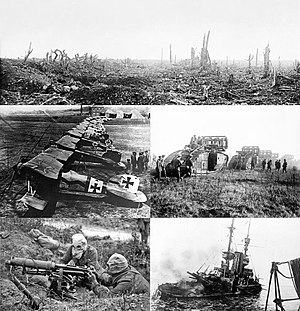
Back Актәи адунеизегьтәи аибашьра Abkhazian Eerste Wêreldoorlog Afrikaans Erster Weltkrieg ALS የመጀመሪያው የዓለም ጦርነት Amharic Primera Guerra Mundial AN Fyrst Woruldgūþ ANG الحرب العالمية الأولى Arabic لحرب لعالمية لولة ARY الحرب العالميه الاولانيه ARZ প্ৰথম বিশ্বযুদ্ধ Assamese
| World War I | |||||||||
|---|---|---|---|---|---|---|---|---|---|
 (Clockwise from the top)
| |||||||||
| |||||||||
| Belligerents | |||||||||
|
Central Powers: (1914-1918) (1914-1918) (1914-1918) (1915-1918) | |||||||||
| Commanders and leaders | |||||||||
|
Main Allied Leaders
|
Main Central Leaders
| ||||||||
| Strength | |||||||||
| Total: 42,959,850[1] | Total: 25,248,321[1] | ||||||||
| Casualties and losses | |||||||||
|
Military deaths by country[5] | ||||||||

World War I (WWI or WW1), also called the First World War, began on July 28, 1914 and lasted until November 11, 1918. It was a global war and lasted exactly 4 years, 3 months and 2 weeks. Most of the fighting was in continental Europe.
Soldiers from many countries took part, and it changed the colonial empires of the European powers. Before World War II began in 1939, World War I was called the Great War, or the World War. Other names are the Imperialist War and the Four Years War. There were 135 countries that took part in World War I, and almost 10 million people died while fighting.[7]
Before the war, European countries had formed alliances to protect themselves. However, that made them divide themselves into two groups. When Archduke Franz Ferdinand of Austria was assassinated on June 28, 1914, Austria-Hungary blamed Serbia and declared war on it. Russia then declared war on Austria-Hungary, which set off a chain of events in which members from both groups of countries declared war on each other.
The 2 sides were the Allied Powers (mainly Russia, France, the British Empire and later the United States) and the Central Powers (mainly German Empire, Austria-Hungary and the Ottoman Empire).
There was fighting in many different fronts (areas). The French and the British fought the Germans on the Western Front in France and Belgium. Germany had tried to defeat France quickly with the Schlieffen Plan but were stopped in the First Battle of the Marne. Most of the fighting on the western front was trench warfare. The Russians fought the Germans and Austro-Hungarians on the Eastern Front in Central and Eastern Europe. Fighting on the eastern front was not trench warfare as in the west, but mobile warfare. The other main areas of fighting were in the Middle East, in the Gallipoli region of the Ottoman Empire and between Italy and Austria-Hungary. Fighting also took place in Africa, China, at sea and in the air. World War I was the first major war in which tanks, airplanes and submarines (or U-boats) were important weapons.
Cite error: There are <ref group=lower-alpha> tags or {{efn}} templates on this page, but the references will not show without a {{reflist|group=lower-alpha}} template or {{notelist}} template (see the help page).
- ↑ 1.0 1.1 Tucker & Roberts 2005, p. 273
- ↑ "British Army statistics of the Great War". Retrieved 13 December 2011.
- ↑ Figures are for the British Empire
- ↑ Figures are for Metropolitan France and its colonies
- ↑ 5.0 5.1 "Page non disponible" (PDF). Archived from the original (PDF) on 2021-02-02. Retrieved 2019-06-19.
- ↑ Nash (1976). Darkest Hours. Rowman & Littlefield. ISBN 978-1590775264.
- ↑ "Military Casualties of World War One". Archived from the original on 2018-06-28. Retrieved 2008-03-10.